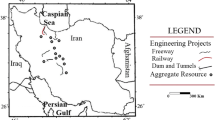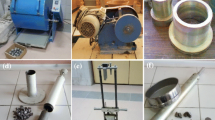Abstract
Ten per cent fines load and ACV tests are two well accepted tests for assessing the mechanical properties of aggregates. While the load producing ten per cent fines is determined in the former test, the amount of fines produced under 40 ton load is given as ACV in the latter test. Both tests are standardised in the U.K. and carried out in the same way, on the approximately same amount of aggregate.
Shergold and Hosking (1959) showed for a number of materials including two rock types that the fines versus load relation in the aggregate crushing test gave a non-linear relation. They also suggested that there was a linear relation between 7.5 to 12.5% fines range, passing through the coordinates (0.–4) in the fines versus load diagram, irrespective of rock types. Based on this assumption, they proposed a means of estimating the ten per cent fines load of aggregate from the crushing test. This method was also accepted by the British Standards (BS 812-1975).
The analysis of experimental and published aggregate test results indicate that the fines versus load relation of aggregates is linear and has a varying intercept and slope in the fines versus load diagram. Based on this concept, a diagram was produced to determine the ACV of aggregates from the ten per cent fines load, or vice versa. In general, an acceptable fit was obtained between the best fitting line to the test results and the proposed relation except for the ACV greater than 30. The proposed relation is not only very simple to apply, but also enables the determination of any per cent of fines load from a minimum number of experiments. Additionally, the proposed relation between the ten per cent fines load and the ACV of aggregates increased the applicability of the specifications which are often given in terms of one of the aggregate test results or determination of an aggregate property from other known properties.
Résumé
Les essais «10% fines load» (charge produisant 10% de passant à 2,4 mm) et «Aggregate Crushing Value, A.C.V.» (essai d'écrasement) sont deux essais bien acceptés en Grande-Bretagne pour caractériser les propriétés mécaniques des granulats. Dans le premier essai, on détermine la charge produisant 10% des «fines», alors que dans le second c'est la quantité de fines produites sans une charge de 40 tonnes qui est déterminée. Les deux essais sont normalisés en Grande-Bretagne et mis en œuvre de la même manière sur des quantités de granulats à peu prés identiques.
Shergold et Hosking (1959) ont montré, sur un certain nombre de matériaux enfermant deux types de roches différents, que la relation quantité de fines par rapport à la charge dans l'essai A.C.V. n'était pas linéaire; ils ont aussi suggéré qu'il y avait une relation linéaire dans la fourchette 7,5%–12.5% de fines, quel que soit les types de roches. A partir de cette hypothèse, ils ont proposé un moyen d'estimer le «ten per cent fines load» à partir de l'«Aggregate Crushing Value». Cette méthode fut également acceptée par les «British Standards» (BS 812-1975).
L'analyse des résultats d'essais expérimentaux publiés montre que la relation fines/charges est linéaire, avec une ordonnée à l'origine et une pente variables. A partir de cette observation diagramme a été établi pour déterminer l'«A.C.V.» à partir du «10% fines load» et vice-versa. En général une corrélation correcte fut obtenue entre la courbe expérimentale et la relation proposée, sauf pour les valeurs d'«A.C.V.», supérieures à 30. La relation proposée est d'application simple et permet aussi la détermination de n'importe quelle valeur du «10% fines load» à partir d'un nombre minimum d'essais. De plus, la relation proposée entre les essais «10% fines load» et «A.C.V.» ont amélioré les possibilités de mise en œuvre des spécifications pour les granulats.
Similar content being viewed by others
References
BS 812—1975: Sampling and Testing of Mineral Aggregates, Sands and Filler (in 4 parts). British Standards Institution, London.
BS 882—1983: British Standard Specification for Aggregates from Natural Sources for Concrete. 7 p. British Standards Institution, London.
COX E.A. 1973: Roadstone Assessment—an Art or a Science?Quarry Managers Jl. 57, 169–77.
DEPARTMENT OF TRANSPORT, 1976: Specification for Road and Bridge Works and Technical Memorandum H16/76. Specification Requirements for Aggregate Properties and Texture Depth for Bituminous Surfacings to New Roads.
EDWARDS A.G. 1967: Properties of Concrete made with Scottish Crushed Rock Aggregates. U.K. Build. Res. Stn. Garston., Eng. Pap. 42.
COLLIS L. and FOX R.A. 1985: Sand, Gravel and Crushed Rock Aggregates for Construction Purposes. The Draft Report. The Geological Society of London, Engineering Group Working Party. 220 p. London.
LEVERETT I.J., 1970: Evaluation of rock for use as aggregates and roadstone.Quarry Managers Jl. London.
MARKWICK A.H.D. and SHERGOLD F.A. 1945: The Aggregate Crushing Test. Jl.Institution of Civil Engineers 24 (6), 125–133.
PROPERTY SERVICES AGENCY, 1979: Standard Specification Clauses for Airfield Pavement Works. Part 4. Bituminous Surfacing.
RAMSAY D.M., DHIR R.K. and SPENCE T.M., 1974: The Role of Rock and Clast Fabric in the Physical Performance of Crushed Rock Aggregate.Engineering Geology, 8, 267–285.
ROAD Note 24, 1959: Roadstone Test Data Presented in Tabular Form. Road Research Laboratory, H.M.S.O. London.
ROAD Note 39, 1972: Recommendations for Road Surface Dressing. T.R.R.L. H.M.S.O. London.
ROAD Note 39, 1979: Surface Dressing. Proposed Amendments to Road Note 39. T.R.R.L. H.M.S.O. London.
SHERGOLD F.A. 1948: A Review of Available Information on the Significance of Roadstone Tests. Road Research Technical Paper 10. D.S.I.R. H.M.S.O. London.
SHERGOLD F.A. and HOSKING T.R. 1959: A New Method of Evaluating the Strength of Roadstone.Roads and Road Construction, June, 164–167.
WEINERT H.H. 1980: The Aggregate Crushing Value and the Ten Per Cent Fines Aggregate Crushing Test Compared. Proc. 7th Regional Conference for Africa on Soil Mechanics and Foundation Engineering, Accra, Ghana. Eds. M.O. Gidigasu, A.A. Hammond and T.O. Gogo, Vol. 1, 191–200. A.A. Balkema, Rotterdam.
Author information
Authors and Affiliations
Rights and permissions
About this article
Cite this article
Turk, N., Dearman, W.R. An investigation of the relation between ten per cent fines load and crushing value tests of aggregates (U.K.). Bulletin of the International Association of Engineering Geology 39, 145–154 (1989). https://doi.org/10.1007/BF02592547
Published:
Issue Date:
DOI: https://doi.org/10.1007/BF02592547




